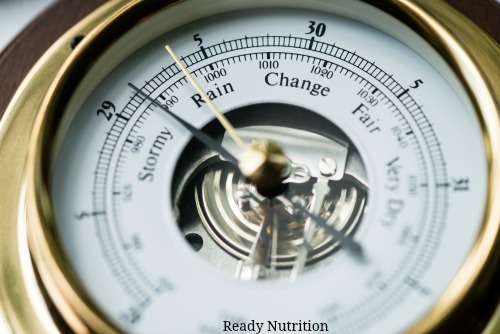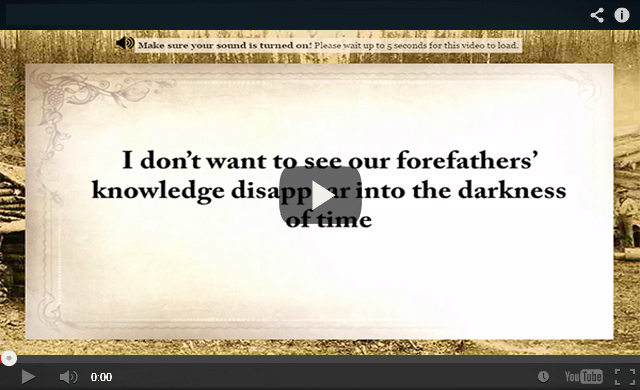This information has been made available by Ready Nutrition. We’re going to cover the weather in this article: how important it is to forecast for bugging out, for your retreat location, and for your operations in a survival scenario.

There is no foolproof method to determine the weather, as it is constantly changing with the introduction of many variables. You can, however, utilize certain clues in your surroundings as well as arm yourself with knowledge of how the weather works and how to determine changes that are significant for you.
In some of these cases, depending on your locale, determining the weather can be a matter of life or death. Here in the Rocky Mountains, you need to know when the snowstorms are coming in, as well as the arctic storms and the serious drops in temperature. If you’re in the outdoors or at home here, you are subject to the temperature and the amount of precipitation and must adjust accordingly either with protective clothing, cessation of travel, or increased measures to protect and heat your home.
Firstly, pick yourself up some kind of reference material on the weather. Keep it simple and perhaps pocket-sized. I really like the old “Zim” guides by Herbert S. Zim on a multitude of subjects ranging from weather to fossils. They’re pocket guides that you can slip into a Ziploc bag to protect that give you information at your fingertips. Always work from low-tech to high-tech. Your Garmin or your Internet-connected Cell Phone are paperweights without power or if they are smashed.
6 Old-Fashioned Ways to Forecast Weather
Cloud reading
This is a great way to determine the changing weather patterns that help you forecast ahead of time. Usually, you can figure out what is going on about 12-18 hours out, or longer. When clouds clump, the weather will dump. An increase in cloud size and thickness usually mean the weather is heading south. Know your types of clouds, as follows:
can figure out what is going on about 12-18 hours out, or longer. When clouds clump, the weather will dump. An increase in cloud size and thickness usually mean the weather is heading south. Know your types of clouds, as follows:
Cirrus: long, high swirls, usually indicators of fairly good weather.
Cumulus: these are the puffed-up “cotton-ball” types of clouds. These when gray (especially in the morning) usually herald a rainstorm. When they form an “anvil” with a flattened bottom, they have changed/denigrated into cumulonimbus clouds, and this means heavy rain with electrical discharges (lightning), and sometimes hail.
Stratus: these have no true top or base, and are unformed layers. These clouds are usually precursors to activity within 24-48 hours, with their graying and massing being late indicators that they are ready to dump some rain or precipitation on you.
The faster the cloud movements across the sky, the greater the change in the wind velocity, usually followed by a change in barometric pressure. Factors such as temperature, humidity, and wind are heavily affected and influenced by the sun. Air rises in the mornings and falls at night. The ground is heated up, and the heat rises, as the cooler air stays closer to the earth when the sun departs. Terrain is a major part of this, as mountains will block or impede air flow, and valleys will hold on to moisture and cold air a lot more readily. Elevation is another big factor, as the temperature of the air decreases by 5.5 degrees for every thousand feet of elevation.
There are some tools you can pick up to help you. An anemometer measures wind speed. It is a four-tined device shaped akin to an “x” with equal parts with cups attached to the ends. As the wind blows, the anemometer measures the speed of the wind. The person recording should continuously note steady wind speed as opposed to gusts, that occur less frequently.
Another good tool is a barometer, that measures the change in air pressure. You may have to search a little to find a good one that is not computerized. Mine was made in West Germany (yeah, it’s that old!) with a little needle you can adjust to mark where the air pressure is, and then (with time’s passage) to see whether the pressure is rising or falling. I stress once again, pick up a model with glass and brass and the needles…no batteries required.
A good sturdy thermometer is also a useful tool to have. Most are “El Cheapo” Chinese-made pieces of junk. There are good ones to be found in scientific supply companies. Anything made by the Germans or Japanese are usually top-flight. Compact, sturdy, and legible are the qualities you’re looking for.
Let’s also explore some other methods to forecast what will occur that are indicators of the natural world. Here’s a few:
Mosquitoes, No-see-um’s, and Black Flies
These guys really bug you, no pun intended, to their maximum potential about 12 hours before a major storm…and they’ll hightail about an hour before the storm hits. Yes, it works. You don’t know when it’s coming, but they do, and by watching them…you’ll know.
The Cricket
Yes, they’re a pain in the backside when you’re trying to sleep, but you can determine the temperature from them. The number of chirps by a cricket over 14 seconds, you add the number 40 to it. Say the cricket chirps 40 times in 14 seconds, then add 40 to that, and the temperature is 80 degrees Fahrenheit. This is accurate to within 1-2 degrees most of the time.
Your Campfire
If the campfire’s smoke is sort of akin to a fog…close to the ground and oozing away toward the rest of the woods? This indicates the potential for rain, because there is a low-pressure system in your area. If the smoke rises straight into the air, it’s high-pressure that is in your area, and the weather will most likely be good.
Frogs
In the spring and summertime, the increased sounds of frogs singing indicates an increased humidity…just prior to the weather heading south. As the low-pressure system moves in, the humidity in the air increases and allows these guys to stay out of the water longer (they breathe through their skin).
Animals and Birds
Sense the approach of storms and (with the former) usually seek shelter out of open areas, or (with the latter) fly to a safer position, such as a tree branch or a niche in the rocks or cliffs.
We haven’t delved into the tactical considerations for knowing the weather. That will be covered in a future article, as it is beyond the scope of what you need for an introduction. Wind, temperature, humidity, and altitude are the factors for consideration when you’re shooting, specifically, when distance shooting for accuracy. All of these factors influence, or are influenced by the weather.
So, in conclusion, we have covered some basics to start you with weather forecasting. Whether you’re in a field environment in a backpacking or camping mode, or just trying to figure out whether you can repair the shingles on your barn before the rain hits, it is important to gauge what you see and compare it to what will be. All comments and information you may wish to share are welcomed and encouraged.
JJ
There are so many things you can learn from our ancestors, from forecasting the weather to preserving your food for survival. Watch the video below and discover the lost skills our forefathers had and got lost throughout time.
CHECK OUR survival and prepping solutions
If you found this article useful, please like our Facebook page and stay up to date with the latest articles.
WHAT TO READ NEXT:
HOW TO MAKE YOUR OWN BACON (STEP BY STEP GUIDE)
A RETURN TO THE OLD PATHS: HOW TO MAKE PEMMICAN LIKE THE NATIVE AMERICANS
20 LOST RECIPES FROM THE PIONEERS: WHAT THEY COOKED IN THEIR JOURNEY WESTWARD
SEVEN CLASSIC GREAT DEPRESSION ERA RECIPES GRANDMA USED TO MAKE
POTTED MEAT: A LOST SKILL OF LONG TERM MEAT STORAGE
BACK TO BASICS: HOW TO MAKE AND PRESERVE LARD
THE BEST WAY TO STOCKPILE VEGETABLES OFF-GRID
OLD FASHIONED PRESERVING-GRANDPA’S RECIPE FOR CURED SMOKED HAM
HOW TO MAKE GUNPOWDER THE OLD FASHIONED WAY
SURVIVAL HERBAL RECIPES FROM OUR ANCESTORS
HOW TO PRESERVE MEAT FOR SURVIVAL LIKE OUR GRANDFATHERS
OTHER USEFUL RESOURCES:
The 3 Pioneer Survival Lessons We Should Learn
The Most Effective Home Defense Strategies
Old School Hacks for Off-Grid Living
The Medical Emergency Crash Course
The Smart, Easy Way to Food Independence
How to Survive the Coming 100 Years Long Drought
Jeremiah Johnson is the Nom de plume of a retired Green Beret of the United States Army Special Forces (Airborne). Mr. Johnson was a Special Forces Medic, EMT and ACLS-certified, with comprehensive training in wilderness survival, rescue, and patient-extraction. He is a Certified Master Herbalist and a graduate of the Global College of Natural Medicine of Santa Ana, CA. A graduate of the U.S. Army’s survival course of SERE school (Survival Evasion Resistance Escape), Mr. Johnson also successfully completed the Montana Master Food Preserver Course for home-canning, smoking, and dehydrating foods.
Mr. Johnson dries and tinctures a wide variety of medicinal herbs taken by wild crafting and cultivation, in addition to preserving and canning his own food. An expert in land navigation, survival, mountaineering, and parachuting as trained by the United States Army, Mr. Johnson is an ardent advocate for preparedness, self-sufficiency, and long-term disaster sustainability for families. He and his wife survived Hurricane Katrina and its aftermath. Cross-trained as a Special Forces Engineer, he is an expert in supply, logistics, transport, and long-term storage of perishable materials, having incorporated many of these techniques plus some unique innovations in his own homestead.
Mr. Johnson brings practical, tested experience firmly rooted in formal education to his writings and to our team. He and his wife live in a cabin in the mountains of Western Montana with their three cats.

